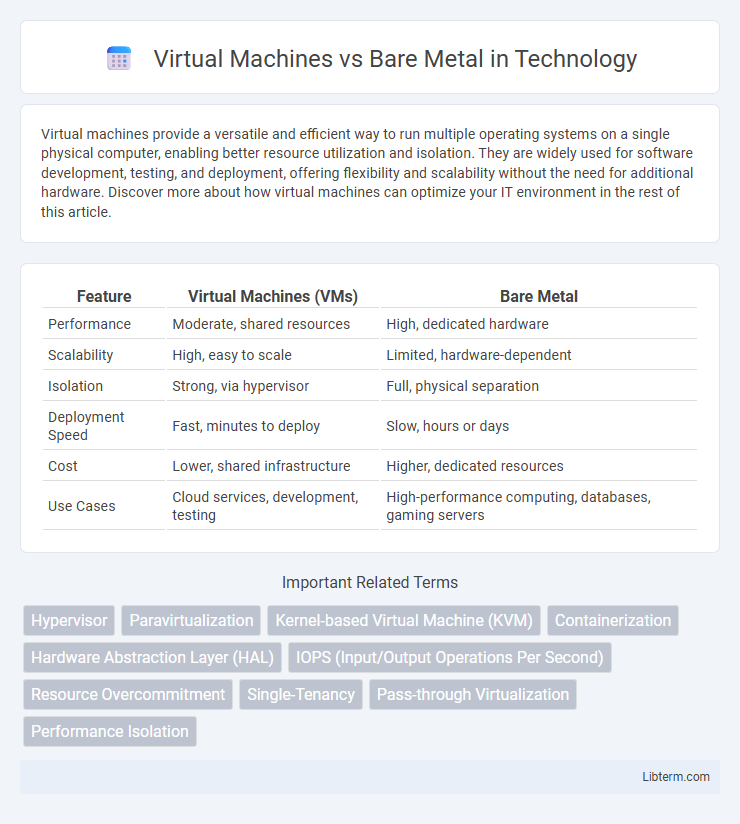Virtual machines provide a versatile and efficient way to run multiple operating systems on a single physical computer, enabling better resource utilization and isolation. They are widely used for software development, testing, and deployment, offering flexibility and scalability without the need for additional hardware. Discover more about how virtual machines can optimize your IT environment in the rest of this article.
Table of Comparison
| Feature | Virtual Machines (VMs) | Bare Metal |
|---|---|---|
| Performance | Moderate, shared resources | High, dedicated hardware |
| Scalability | High, easy to scale | Limited, hardware-dependent |
| Isolation | Strong, via hypervisor | Full, physical separation |
| Deployment Speed | Fast, minutes to deploy | Slow, hours or days |
| Cost | Lower, shared infrastructure | Higher, dedicated resources |
| Use Cases | Cloud services, development, testing | High-performance computing, databases, gaming servers |
Introduction to Virtual Machines and Bare Metal
Virtual machines (VMs) are software-based emulations that run on top of physical hardware, enabling multiple isolated operating systems to operate concurrently on a single server. Bare metal refers to physical servers without any virtualization layer, offering direct access to hardware for maximum performance and resource control. Choosing between VMs and bare metal depends on workload requirements, with VMs providing flexibility and scalability, while bare metal delivers superior speed and hardware optimization.
Core Differences Between Virtual Machines and Bare Metal
Virtual machines run on hypervisors that abstract physical hardware, allowing multiple isolated OS instances to share a single physical server, which enhances resource utilization but introduces overhead and potential latency. Bare metal servers provide direct access to physical hardware without intermediate layers, offering superior performance and control ideal for high-demand workloads. The core differences include virtualization overhead, resource allocation flexibility in VMs, and the dedicated, predictable performance in bare metal environments.
Performance Comparison: VM vs Bare Metal
Bare metal servers deliver superior performance compared to virtual machines by providing direct access to hardware resources without the overhead of a hypervisor layer. Virtual machines introduce latency and resource contention due to shared CPU, memory, and storage, which can impact high-performance workloads. Benchmark tests consistently show bare metal environments outperform VMs in terms of input/output operations per second (IOPS), network throughput, and CPU-intensive tasks.
Security Implications: Virtual Machines vs Bare Metal
Virtual Machines (VMs) isolate workloads through hypervisor-enforced virtualization, reducing the attack surface by sandboxing applications, but introduce risks such as hypervisor vulnerabilities and potential VM escape exploits. Bare Metal servers provide direct hardware access, minimizing layers and potential hypervisor-related attack vectors, enhancing security for sensitive workloads but lacking virtualization's flexibility and rapid recovery options. Security strategies must weigh hypervisor threat mitigation against the physical hardware protection and monitoring needed for Bare Metal environments.
Scalability and Flexibility Considerations
Virtual machines offer enhanced scalability by allowing multiple instances to run simultaneously on a single physical server, facilitating dynamic resource allocation and rapid deployment. Bare metal servers provide superior performance and resource control, but scaling requires provisioning additional physical hardware, which can be time-consuming and costly. Flexibility in virtual machines supports diverse workloads and quick environment changes, whereas bare metal environments are better suited for consistent, high-demand applications requiring dedicated resources.
Cost Analysis: Virtual Machines vs Bare Metal
Virtual machines (VMs) typically offer lower upfront costs and greater scalability compared to bare metal servers, as multiple VMs can share the same physical hardware resources efficiently. Bare metal servers often involve higher capital expenditure due to dedicated hardware procurement but provide predictable performance and potentially lower long-term costs when high and consistent workloads are present. Cost analysis must also consider factors like deployment speed, management overhead, and energy consumption, where VMs generally reduce operational expenses through automation and resource optimization.
Deployment Speed and Management
Virtual machines enable rapid deployment through pre-configured templates and automated provisioning, significantly reducing setup time compared to bare metal servers that require manual OS installation and hardware configuration. VM environments support centralized management tools for easy scaling, snapshots, and resource allocation, whereas bare metal demands direct hardware interaction and more complex maintenance. The abstraction layer in VMs boosts flexibility but may introduce slight performance overhead not present in bare metal setups.
Use Case Scenarios for Virtual Machines
Virtual machines are ideal for development and testing environments where rapid provisioning, snapshotting, and rollback are crucial, enabling isolated instances without affecting the host system. They excel in multi-tenant cloud hosting, allowing service providers to maximize resource utilization and isolate customer workloads securely. Virtual machines also support legacy application migration by emulating older hardware, facilitating seamless operation without dedicated physical infrastructure.
Use Case Scenarios for Bare Metal
Bare Metal servers are ideal for high-performance computing tasks such as database management, large-scale virtualization, and gaming servers that demand direct hardware access for maximum speed and low latency. Use cases also include workloads requiring extensive customization and security compliance, like financial services and healthcare applications, where dedicated environments prevent resource contention. Enterprises deploying AI training models or big data analytics benefit from Bare Metal's raw power and predictable performance, ensuring efficient processing of intensive computations.
Choosing the Right Infrastructure for Your Needs
Choosing between virtual machines and bare metal depends on workload requirements, with virtual machines offering scalability and resource efficiency ideal for dynamic or multi-tenant environments. Bare metal servers provide dedicated hardware performance essential for high-compute tasks, low-latency applications, and data-intensive workloads. Consider factors such as workload isolation, budget constraints, and maintenance capabilities to align infrastructure choice with operational goals.
Virtual Machines Infographic

 libterm.com
libterm.com